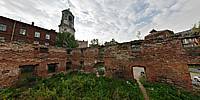
Vyborg Old Cathedral
Vyborg, Russia
September 18, 2014, 06:10 UTC (10:10 local time)
© 2014 Andrew Varlamov, All Rights Reserved.
During the centuries the Vyborg cathedral was first Catholic, then Lutheran and during the Russian order also an Orthodox church. Peter the Great ordered to renovate it for Orthodox worships in 1720. In 1805 it was remodified as a magazine. In 1913 the cathedral was again restored and after the Independence of Finland it was moved once again Lutheran church. In the Winter War (1940) the aerial bomb hit the church and only walls survived.
The bell, which you hear, was donated for Vyborg by Catherine the Great after a fire in 1793.
Links for home reading:
- Article (in Russian) and photos from Rustikivi (private archive of Karelian Isthmus)
- History of Clock Tower (Englsih translation from Russian)
Lens: Samyang 8mm f/3.5 UMC Fish-eye CS II
Panohead: Nodal Ninja Ultimate R10 + Quick Mount Mini Adapter Plate + Ultimate R1/R10 Zenith / Nadir Adapter
Pole: Fanotec Carbon Fiber Pole Series 2
Rotator: Fanotec Pole Rotator 45 degree stops
Sound Recorder: Pentax Optio 450 Digital Camera
Footplate: Fanotec
PC Software: PTGui Pro 10.0.6 by New House Internet Services B.V. (dated by September 5, 2014), Pano2QTVR Pro Flash version 1.6.6 by Thomas Rauscher
The next citation from orange pocket guide of Manifesta 10 describes the scene:
"On the occasion of its 250th anniversary, the Hermitage Museum invited Manifesta to research the role and notion of contemporary art in historical museums in the twenty-first century. At the same time, Manifesta is celebrating its twentieth year of existence. These two iconic moments combine to provide a wonderful opportunity for critical reflection on how contemporary art plays a role in our world today, as compared to the role it played for Catherine the Great, 250 years ago" - reported Hedwig Fijen, Director of Manifesta, and Mikhail Piotrovsky, Director of the State Hermitage Museum, on page 22.
And further on page 116 - "ABSCHLAG is the title as well as the form of Thomas Hirschhorn's project in the inner courtyard of the new General Staff Building. It means that an important part of a whole - such as facade of an architectural oeuvre - has been cut off. In this sense it opens the formerly invisible and forgotten inside up to the eye with its remnants of living spaces, wallpapers, and dangling lamps. In its two plastic dimensions - the vertical of the still-standing, cut open building, and the horizontal one in the form of collapsed walls, floors, and fallen bricks on the ground that have to be bypassed - ABSCHLAG references revolutionary Russian Constructivists Kazimir Malevich, Pavel Filonov and Olga Rozanova commitment to and fighting for artistic truth".


 Tap or click the zoom icon in the bottom right corner of the picture to switch between in-page and fullscreen view
Tap or click the zoom icon in the bottom right corner of the picture to switch between in-page and fullscreen view